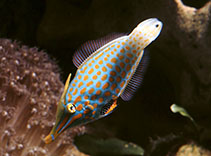| Family: |
Monacanthidae (Filefishes) |
| Max. size: |
12 cm TL (male/unsexed) |
| Environment: |
reef-associated; marine; depth range 1 - 35 m, non-migratory |
| Distribution: |
Indo-Pacific: East Africa south to Maputo, Mozambique (Ref. 4421) and east to Samoa, north to Ryukyu Islands, south to the southern Great Barrier Reef, New Caledonia, and Tonga. Replaced by Oxymonacanthus halli in the Red Sea. |
| Diagnosis: |
Dorsal spines (total): 2-2; Dorsal soft rays (total): 31-35; Anal spines: 0-0; Anal soft rays: 29-32. Ventral rudiment absent; bristles on caudal peduncle of males longer than others on body (Ref. 37816).
Description: Characterized by green body color with 6-7 rows of orange spots; posterior caudal fin with black spot or bar; male with white-spotted black patch on pelvic flap; female with black coloration on flap, but lacks white spots; first dorsal spine shorter than snout, origin above posterior half of eye, folding into groove along back; long, tapering and tubular snout; rudiment, small and immovable pelvic fin; short and slightly rounded caudal fin; depth of body at origin of anal fin 3.1-3.3 in SL (Ref. 90102). |
| Biology: |
Occurs in clear lagoon and seaward reefs from 0.5 to at least 30 m. Found in pairs or small groups and nests near bases of dead corals, often on clumps of algae. Monogamous (Ref. 52884, 48637). Feeds exclusively on Acropora polyps. Feeding takes place throughout the day becoming less towards the evening (Ref. 46144). |
| IUCN Red List Status: |
Vulnerable (VU); Date assessed: 05 July 2015 (A3c) Ref. (130435)
|
| Threat to humans: |
harmless |
Source and more info: www.fishbase.org. For personal, classroom, and other internal use only. Not for publication.

